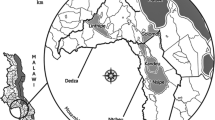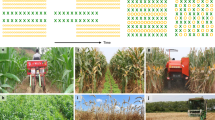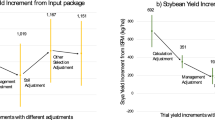Abstract
In Rwanda, farmers’ traditional farming systems based on intercropping and varietal mixtures are designed to meet a variety of livelihood objectives and withstand risks associated with fluctuation in market and agro-climatic conditions. However, these mixed systems have been disappearing since 2008 when government mandated intensification strategies. In this paper we use a mixed methods approach to evaluate intercropping and sole cropping systems against farmers’ criteria for success: yield, market value, contribution to nutritional quality, and land-use efficiency. We used qualitative interviews to understand the criteria by which farmers evaluate cropping systems, and data from crop trials to assess common bean ((Phaseolus vulgaris L.) and maize (Zea mays L.)) sole crops and intercrops against those criteria. We found that an improved intercropping system tends to outperform the government-mandated system of alternating sole-cropped bean and maize season-by-season, on all four of the criteria tested. Although Rwanda’s agricultural intensification strategy aims to improve rural livelihoods through agricultural modernization, it fails to acknowledge the multiple and currently non-replaceable benefits that diverse cropping systems provide, particularly food security and risk management. Agricultural policies need to be based on a better understanding of smallholders’ objectives and constraints. Efforts to improve farming systems require innovative and inclusive approaches that enable adaptation to the socio-ecological context.



Similar content being viewed by others
References
Altieri, M. A. (1999). The ecological role of biodiversity in agroecosystems. Agriculture, Ecosystems & Environment, 74, 19–31.
Altieri, M. A. (2004). Linking ecologists and traditional farmers in the search for sustainable agriculture. Frontiers in Ecology and the Environment, 2, 35–42.
Ansoms, A. (2008). Striving for growth, bypassing the poor? A critical review of Rwanda’s rural sector policies. The Journal of Modern African Studies, 46, 1–32.
Arimond, M., & Ruel, M. T. (2004). Dietary diversity is associated with child nutritional status: evidence from 11 demographic and health surveys. Journal of Nutrition, 134, 2579–2585.
Ashby, J. A., & Sperling, L. (1995). Institutionalizing participatory, client-driven research and technology development in agriculture. Development and Change, 26, 753–770.
Bellon, M. R. (1996). The dynamics of crop infraspecific diversity: a conceptual framework at the farmer level 1. Economic Botany, 50, 26–39.
Berti, B. R., & Jones, A. D. (2013). Biodiversity’s contribution to dietary diversity. In J. Fanzo, D. Hunter, T. Borelli, & F. Mattei (Eds.), Diversifying Food and Diets: Using Agricultural Biodiversity to Improve Nutrition and Health. Abingdon: Routledge.
Blarel, B., Hazell, P., Place, F., & Quiggin, J. (1992). The economics of farm fragmentation: evidence from Ghana and Rwanda. The World Bank Economic Review, 6, 233–254.
Boudreau, M. A. (2013). Diseases in intercropping systems. Annual Review of Phytopathology, 51, 499–519.
Bressani, R. (1983). Research needs to upgrade the nutritional quality of common beans (Phaseolus vulgaris). Qual. Pl. Plant Foods Human Nutr., 32, 101–110.
Broughton, W. J., Hernández, G., Blair, M., Beebe, S., Gepts, P., & Vanderleyden, J. (2003). Beans (Phaseolus spp.) – model food legumes. Plant and Soil, 252, 55–128.
Brush, S. B. (2000). Genes in the field: On-farm conservation of crop diversity. IPGRI, Lewis Publishers, IDRC.
Conelly, W., & Chaiken, M. (2000). Intensive farming, agro-diversity, and food security under conditions of extreme population pressure in western Kenya. Human Ecology, 28, 19–51.
Connolly, J., Goma, H. C., & Rahim, K. (2001). The information content of indicators in intercropping research. Agriculture, Ecosystems & Environment, 87(2), 191–207. doi:10.1016/S0167-8809(01)00278-X.
Darnhofer, I., Bellon, S., Dedieu, B., & Milestad, R. (2010a). Adaptiveness to enhance the sustainability of farming systems. A review. Agronomy for Sustainable Development, 30, 11.
Darnhofer, I., Fairweather, J., & Moller, H. (2010b). Assessing a farm’s sustainability: insights from resilience thinking. International Journal of Agricultural Sustainability, 8, 186–198.
De Janvry, A., Fafchamps, M., & Sadoulet, E. (1991). Peasant household behaviour with missing markets: some paradoxes explained. The Economic Journal, 101(409), 1400. doi:10.2307/2234892.
Declerck, F. A. J., Fanzo, J., Palm, C., & Remans, R. (2011). Ecological approaches to human nutrition. Food & Nutrition Bulletin, 32(1), 41S–50S.
DeWalt, B. R. (1994). Using indigenous knowledge to improve agriculture and natural resource management. Human Organization, 53, 123–131.
Döring, T. F., Vieweger, A., Pautasso, M., Vaarst, M., Finckh, M. R., & Wolfe, M. S. (2014). Resilience as a universal criterion of health. Journal of the Science of Food and Agriculture, 95(3), 455–465.
Eastern and Southern Africa Regional Maize Conference, Friesen, D. K., Palmer, A. F. E., International Maize and Wheat Improvement Center, African Livelihoods Program, International Maize and Wheat Improvement Center, Maize Improvement Program & Kenya Agricultural Research Institute (eds). (2004). Integrated Approaches to Higher Maize Productivity in the New Millennium: Proceedings of the Seventh Eastern and Southern Africa Regional Maize Conference, Nairobi, Kenya, 5–11 February 2002. CIMMYT, African Livelihoods Program : Kenya Agricultural Research Institute, [Nairobi].
FAO (1996). Declaration on world food security. FAO, Rome: World Food Summit.
Federer, W. T. (2012). Statistical design and analysis for intercropping experiments: Volume 1: Two crops. Springer Science & Business Media.
Folke, C., Carpenter, S. R., Walker, B., Scheffer, M., Chapin, T., & Rockström, J. (2010). Resilience thinking: integrating resilience, adaptability and transformability. Ecology and Society, 15, 20.
Francis, C. A. (1989). Biological efficiencies in multiple-cropping systems. Advances in Agronomy, 42, 1–42.
Francis, C. A., & Sanders, J. H. (1978). Economic analysis of bean and maize systems: monoculture versus associated cropping. Field Crops Research, 1, 319–335.
Fukai, S., & Trenbath, B. R. (1993). Processes determining intercrop productivity and yields of component crops. Field Crops Research, 34, 247–271.
Garrity, D., Dixon, J., & Boffa, J. M. (2012). Understanding African farming systems. Canberra: Australian International Food Security Centre.
Ghanbari, A., Dahmardeh, M., Siahsar, B. A., & Ramroudi, M. (2010). Effect of maize (Zea Mays L.) - cowpea (Vigna Unguiculata L.) intercropping on light distribution, soil temperature and soil moisture in arid environment. International journal of food, agriculture and environment, 8, 102–108.
Graham, P. H., & Ranalli, P. (1997). Common bean (Phaseolus Vulgaris L.). Field Crops Research, 53(1–3), 131–146.
Greenwood, D. J., & Levin, M. (2007). Introduction to Action Research: Social Research for Social Change. Thousand Oaks: SAGE Publications.
Hajjar, R., Jarvis, D. I., & Gemmill-Herren, B. (2008). The utility of crop genetic diversity in maintaining ecosystem services. Agriculture, Ecosystems & Environment, 123, 261–270.
Herforth, A., Frongillo, E. A., Sassi, F., Mclean, M. S., Arabi, M., Tirado, C., et al. (2014). Toward an integrated approach to nutritional quality, environmental sustainability, and economic viability: research and measurement gaps. Annals of the New York Academy of Sciences, 1332, 1–21.
HLPE (2013). Investing in smallholder agriculture for food security. Rome: A report by the High Level Panel of Experts on Food Security and Nutrition of the Committee on World Food Security.
Hoffmann, V., Probst, K., & Christinck, A. (2007). Farmers and researchers: how can collaborative advantages be created in participatory research and technology development? Agriculture and Human Values, 24, 355–368.
Hooper, D. U., Chapin, F. S., Ewel, J. J., Hector, A., Inchausti, P., Lavorel, S., et al. (2005). Effects of biodiversity on ecosystem functioning: a consensus of current knowledge. Ecological Monographs, 75, 3–35.
Howe, G., & McKay, A. (2007). Combining quantitative and qualitative methods in assessing chronic poverty: the case of Rwanda. World Development, 35, 197–211.
Huggins, C. (2013). Consolidating land, consolidating control: State-facilitated ‘agricultural investment’ through the ‘Green Revolution’ in Rwanda. Land Deal Politics Initiative (LDPI) Working Paper 16.
Isaacs, K. B. (2014). Rediscovering the value of crop diversity in Rwanda: Participatory variety selection and genotype by cropping system interactions in bean and maize systems. Michigan State University. Retrieved from http://gradworks.umi.com/36/19/3619033.html
Jackson, L. E., Pulleman, M. M., Brussaard, L., Bawa, K. S., Brown, G. G., Cardoso, I. M., et al. (2012). Social-ecological and regional adaptation of agrobiodiversity management across a global set of research regions. Global Environmental Change, 22, 623–639.
Jodha, N. S. (1980). Intercropping in traditional farming systems. Journal of Development Studies, 16, 427–442.
Johns, T. & Eyzaguirre, P.B. (2006). Linking Biodiversity, Diet and Health in Policy and Practice. Proceedings of the Nutrition Society, 65, 182–189.
Jones, A. D., Shrinivas, A., & Bezner-Kerr, R. (2014). Farm production diversity is associated with greater household dietary diversity in Malawi: findings from nationally representative data. Food Policy, 46, 1–12.
Kangasniemi, J. (1998). People and bananas on the steep slopes: agricultural intensification and food security under demographic pressure and environmental degradation in Rwanda. East Lansing: Michigan State University.
Kremen, C., & Miles, A. (2012). Ecosystem Services in Biologically Diversified versus conventional farming systems: benefits, externalities, and trade-offs. Ecology and Society, 17, 153–177.
Li, L., Tilman, D., Lambers, H., & Zhang, F. S. (2014). Plant diversity and overyielding: insights from belowground facilitation of intercropping in agriculture. New Phytologist, 203, 63–69.
Lin, B. B. (2011). Resilience in agriculture through crop diversification: adaptive management for environmental change. BioScience, 61(3), 183–193. doi:10.1525/bio.2011.61.3.4.
Lithourgidis, A. S., Dordas, C. A., Damalas, C. A., & Vlachostergios, D. N. (2011). Annual intercrops: an alternative pathway for sustainable agriculture. Australian Journal of Crop Science, 5, 396–410.
Malézieux, E. (2012). Designing cropping systems from nature. Agronomy for Sustainable Development, 32, 15–29.
Malézieux, E., Crozat, Y., Dupraz, C., Laurans, M., Makowski, D., Ozier-Lafontaine, H., et al. (2009). Mixing plant species in cropping systems: concepts, tools and models: a review. Sustainable Agriculture, 3, 329–353.
Mead, R., & Riley, J. (1981). A review of statistical ideas relevant to intercropping research. Journal of the royal statistical society. Series A (General), 144(4), 462–509.
Mead, R., Riley, J., Dear, K., & Singh, S. P. (1986). Stability comparison of intercropping and Monocropping systems. Biometrics, 42, 253–266.
Mijatović, D., Van Oudenhoven, F., Eyzaguirre, P., & Hodgkin, T. (2013). The role of agricultural biodiversity in strengthening resilience to climate change: towards an analytical framework. International Journal of Agricultural Sustainability, 11, 95–107.
MINIAGRI (Ministry of Agriculture and Animal Resources). (2004). Strategic plan for agricultural transformation in Rwanda. Republic of Rwanda. Retrieved from: http://www.ifad.org/english/operations/pf/rwa/i671rw/web/final/en/final_nobudget.pdf
MINIAGRI (Ministry of Agriculture and Animal Resources). (2009a). Strategic plan for agricultural transformation in Rwanda - phase II (PSTA II). Republic of Rwanda. Retrieved from: http://www.gafspfund.org/sites/gafspfund.org/files/Documents/Rwanda_StrategicPlan.pdf
MINIAGRI (Ministry of Agriculture and Animal Resources) & Natural Resources & IFDC. (2009b). Rwanda agroecological zones map. From AMITSA: http://www.amitsa.org/
MINIAGRI (Ministry of Agriculture and Animal Resources) and National Institute of Statistics Rwanda (2012). Comprehensive food security and vulnerability analysis and nutrition survey. Rwanda: Ministry of Agriculture and Animal Resources.
Momsen, J. H. (2007). Gender and agrobiodiversity: introduction to the special issue. Singapore Journal of Tropical Geography, 28, 1–6.
Mucheru-Muna, M., Pypers, P., Mugendi, D., Kung’u, J., Mugwe, J., Merckx, R., et al. (2010). A staggered maize–legume intercrop arrangement robustly increases crop yields and economic returns in the highlands of Central Kenya. Field Crops Research, 115, 132–139.
National Institute of Statistics (NIS). (2010). National Agricultural Survey 2008. Republic of Rwanda. Retrieved from: http://www.statistics.gov.rw/publications/national-agricultural-survey-report-nas-2008
Omamo, S. W. (1998). Transport costs and smallholder cropping choices: an application to Siaya District, Kenya. American Journal of Agricultural Economics, 80(1), 116–123. doi:10.2307/3180274.
Power, A. G. (2010). Ecosystem services and agriculture: tradeoffs and synergies. Philosophical Transactions of the Royal Society B: Biological Sciences, 365, 2959–2971.
Quisumbing, A. R. (1996). Male-female differences in agricultural productivity: methodological issues and empirical evidence. World Development, 24, 1579–1595.
Quisumbing, A. R. (2003). Household decisions, gender, and development: A synthesis of recent research., xv + 274 pp. Washington, DC: International Food Policy Research Institute (IFPRI).
Reason, P., & Bradbury, H. (2001). Handbook of Action Research: Participative Inquiry and Practice. London: SAGE Publications.
Remans, R., Wood, S. A., Saha, N., Anderman, T. L., & DeFries, R. S. (2014). Measuring nutritional diversity of national food supplies. Global Food Security, 3, 174–182.
Rubin, H. J., & Rubin, I. S. (2012). Qualitative interviewing: The art of hearing data. Los Angeles: SAGE Publications.
Ruel, M. T. (2003). Operationalizing dietary diversity: a review of measurement issues and research priorities. Journal of Nutrition, 133, 3911S–33926.
Rusinamhodzi, L., Corbeels, M., Nyamangara, J., & Giller, K. E. (2012). Maize–grain legume intercropping is an attractive option for ecological intensification that reduces climatic risk for smallholder farmers in Central Mozambique. Field Crops Research, 136, 12–22.
Seran, T. H., & Brintha, I. (2010). Review on maize based intercropping. Journal of Agronomy, 9, 135–145.
Smale, M. (2005). Valuing Crop Biodiversity: On-Farm Genetic Resources and Economic Change. Wallingford: CABI.
Smith, M. E., & Francis, C. A. (1986). Breeding for multiple cropping systems. In C. A. Francis (Ed.), Multiple cropping (Systems ed.). New York, USA: MacMillan Publishing Company.
Smithson, J. B., & Lenne, J. M. (1996). Varietal mixtures: a viable strategy for sustainable productivity in subsistence agriculture. Annals of Applied Biology, 128, 127–158.
Snapp, S., Kanyama-Phiri, G., Kamanga, B., Gilbert, R., & Wellard, K. (2002). Farmer and researcher partnerships in Malawi: developing soil fertility technologies for the near-term and far-term. Experimental Agriculture, 38, 411–431.
Snapp, S. S., Blackie, M. J., Gilbert, R. A., Bezner-Kerr, R., & Kanyama-Phiri, G. Y. (2010). Biodiversity can support a greener revolution in Africa. Proceedings of the National Academy of Sciences, 201007199.
Sperling, L. and P. Berkowitz. (1994). Partners in Selection: bean breeders and women bean experts in Rwanda. Consultative Group on International Agricultural Research.
Swift, M. J., Izac, A.-M. N., & van Noordwijk, M. (2004). Biodiversity and ecosystem services in agricultural landscapes–are we asking the right questions? Agriculture, Ecosystems & Environment, 104, 113–134.
Thrupp, L.A. (2000). Linking Agricultural Biodiversity and Food Security: The Valuable Role of Sustainable Agriculture. International Affairs (Royal Institute of International Affairs 1944-), 76, 265–281.
Trenbath, B. R. (1986). Resource use by intercrops. In C. A. Francis (Ed.), Multiple Cropping Systems (pp 57–81). New York: MacMillan.
Trenbath, B. R. (1993). Intercropping for the management of pests and diseases. Field Crops Research, 34, 381–405.
Trenbath, B. R. (1999). Multispecies cropping systems in India: predictions of their productivity, stability, resilience and ecological sustainability. Agroforestry Systems, 45, 81–107.
Tscharntke, T., Klein, A. M., Kruess, A., Steffan-Dewenter, I., & Thies, C. (2005). Landscape perspectives on agricultural intensification and biodiversity – ecosystem service management. Ecology Letters, 8, 857–874.
Tscharntke, T., Clough, Y., Wanger, T. C., Jackson, L., Motzke, I., Perfecto, I., et al. (2012). Global food security, biodiversity conservation and the future of agricultural intensification. Biological Conservation, 151, 53–59.
Tsubo, M., Walker, S., & Ogindo, H. O. (2005). A simulation model of cereal–legume intercropping systems for semi-arid regions: II. Model application. Field Crops Research, 93, 23–33.
U.S. Department of Agriculture, Agricultural Research Service. (2013). USDA National Nutrient Database for standard reference, release 26. Retrieved from: Nutrient Data Laboratory Home Page, http://www.ars.usda.gov/ba/bhnrc/ndl
Vandermeer, J. H. (1992). The ecology of intercropping. Cambridge: Cambridge University Press.
Vandermeer, J. H. (2011). The ecology of agroecosystems. Sudbury, Mass: Jones and Bartlett Publishers.
Vandermeer, J., van Noordwijk, M., Anderson, J., Ong, C., & Perfecto, I. (1998). Global change and multi-species agroecosystems: concepts and issues. Agriculture, Ecosystems & Environment, 67, 1–22.
Voss, J. (1992). Conserving and increasing on-farm genetic diversity: Farmer management of varietal bean mixtures. In J. L. Moock & R. E. Rhodes (Eds.), Utilizing and conserving agrobiodiversity in agricultural landscapes (pp. 34–51). Ithaca: Cornell University Press.
Waddington, S. R., Mekuria, M., Siziba, S., & Karigwindi, J. (2007). Long-term yield sus- tainability and financial returns from grain legume–maize intercrops on a sandy soil in sub-humid north Central Zimbabwe. Experimental Agriculture, 43, 489–503.
Walker, B., Sayer, J., Andrew, N.L. & Campbell, B. (2010). Should enhanced resilience Be an objective of natural resource management research for developing countries? Crop Science, 50, S–10–S–19.
Welch, R. M., House W.A, Beebe, S., & Cheng, Z. (2000). Genetic selection for enhanced bioavailable levels of iron in bean (Phaseolus vulgaris L.) seeds. Journal of Agricultural and Food Chemistry, 48, 3576–3580.
Weltzien, E., & Christinck, A. (2011). Participatory breeding: developing improved and relevant crop varieties with farmers. In S. Snapp & B. Pound (Eds.), Agricultural Systems: Agroecology and Rural Innovation for Development: Agroecology and Rural Innovation for Development (pp 209–249). Waltham: Academic Press.
Willey, R. W. (1985). Evaluation and presentation of intercropping advantages. Experimental Agriculture, 21, 119–133.
Wolfe, M. S. (2000). Crop strength through diversity. Nature, 406, 681–682.
World Food Programme. (2012). Rwanda: comprehensive food security and vulnerability analysis and nutrition survey 2012. United Nations World Food Programme: Rome, Italy. http://www.wfp.org/food-security, http://www.statistics.gov.rw
Acknowledgments
We wish to acknowledge Rwanda Agriculture Board (RAB) and Rural Northern Development (DERN) for providing assistance and staff resources in this study. We are grateful to Louis Butare (RAB) for administrative and field assistance and Edouard Murwanashyaka (RAB) and especially Faustin Nshimiyimana (DERN) for providing technical field assistance at the research stations and with data collection. Research was supported by funds from a Fulbright-Hayes Doctoral Dissertation Fellowship and the United States Agency for International Development (USAID) through the Dry Grain Pulses Collaborative Research Support Program (Cooperative Agreement EDH-A-00-07-00005-00). The content is solely the responsibility of the author(s) and does not necessarily represent the official views of the U.S. Agency for International Development (USAID).
Author information
Authors and Affiliations
Corresponding author
Rights and permissions
About this article
Cite this article
Isaacs, K.B., Snapp, S.S., Chung, K. et al. Assessing the value of diverse cropping systems under a new agricultural policy environment in Rwanda. Food Sec. 8, 491–506 (2016). https://doi.org/10.1007/s12571-016-0582-x
Received:
Accepted:
Published:
Issue Date:
DOI: https://doi.org/10.1007/s12571-016-0582-x




